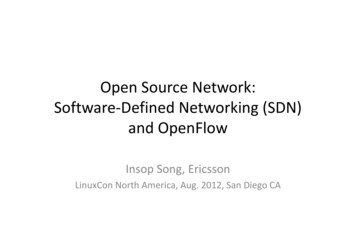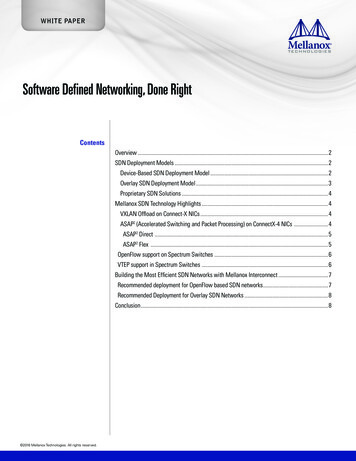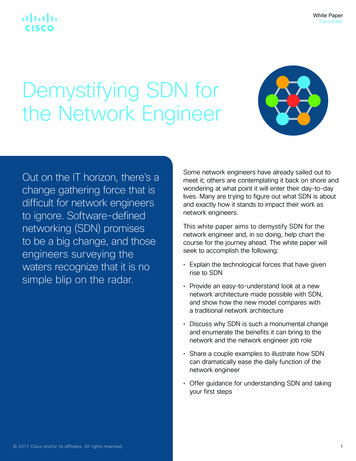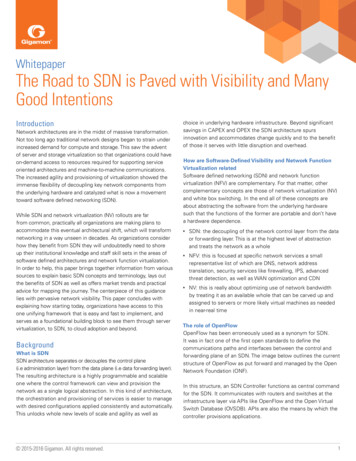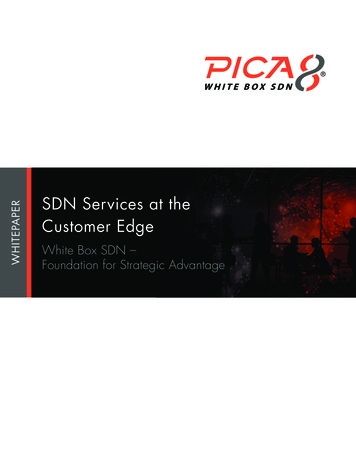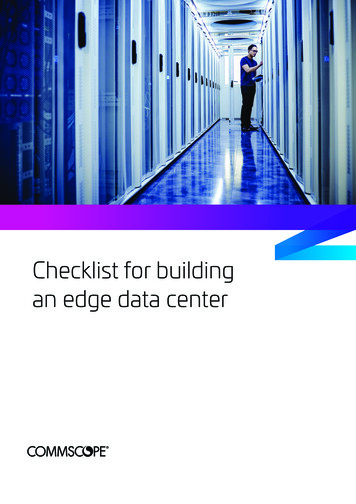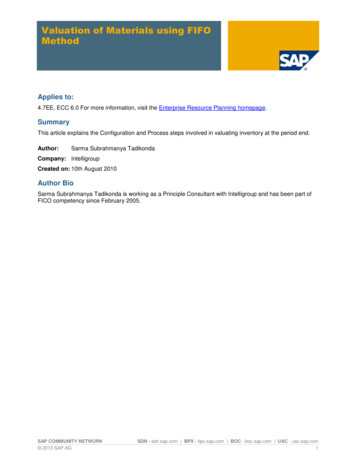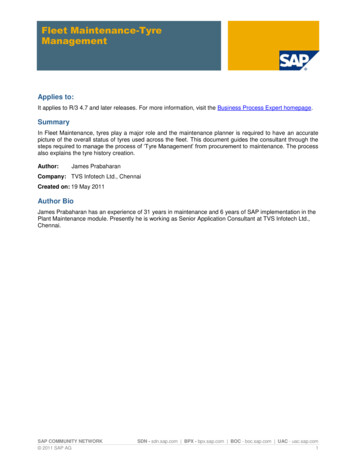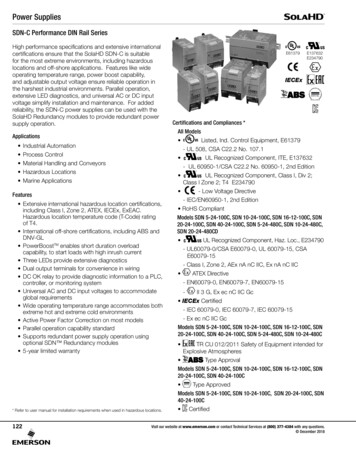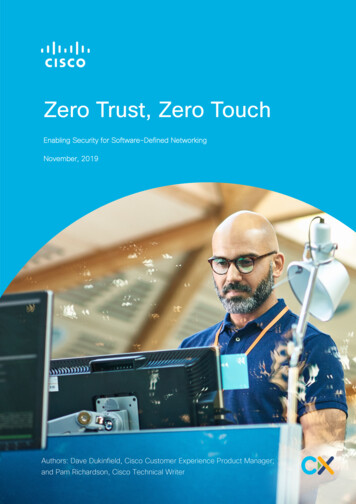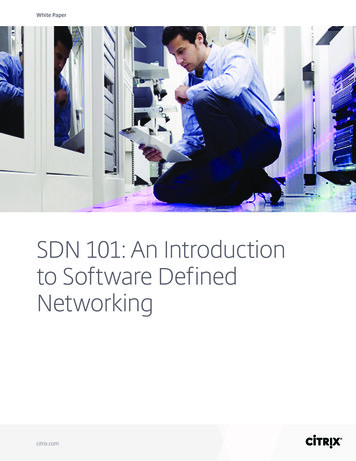
Transcription
White PaperSDN 101: An Introductionto Software DefinedNetworkingcitrix.com
White PaperSDN 101: An Introduction to Software Defined NetworkingOver the last year, the hottest topics in networking have beensoftware defined networking (SDN) and Network Virtualization(NV). There is, however, considerable confusion amongstenterprise IT organizations relative to these topics. There aremany sources of that confusion, including the sheer number ofvendors who have solutions that solve different problems usingdifferent solution architectures and technologies, all of whomclaim to be offering SDN and/or NV solutions.The primary goal of this white paper is to eliminate thatconfusion. In order to accomplish that goal, this white paper willput SDN into the context of a broad movement to have more ofa focus on software based solutions and it will identify the keyopportunities that SDN can address. This white paper will alsodiscuss both SDN and NV and will describe the relationshipbetween these two emerging approaches to networking.BackgroundTraditional Data NetworkIn the traditional approach to networking, most network functionality is implemented in adedicated appliance; i.e., switch, router, application delivery controller. In addition, within thededicated appliance, most of the functionality is implemented in dedicated hardware such asan ASIC (Application Specific Integrated Circuit).Some of the key characteristics of this approach to developing network appliances are: The ASICs that provide the network functionality evolve slowly; The evolution of ASIC functionality is under the control of the provider of the appliance; The appliances are proprietary; Each appliance is configured individually; Tasks such as provisioning, change management and de-provisioning are very timeconsuming and error prone.citrix.com2
White PaperSDN 101: An Introduction to Software Defined NetworkingNetworking organizations are under increasing pressure to be more efficient and agile than ispossible with the traditional approach to networking. One source of that pressure results fromthe widespread adoption of server virtualization. As part of server virtualization, virtual machines(VMs) are dynamically moved between servers in a matter of seconds or minutes. However, ifthe movement of a VM crosses a Layer 3 boundary, it can take days or weeks to reconfigure thenetwork to support the VM in its new location. It can sometimes be difficult to define exactlywhat it means for a network to be agile. That said, if it takes weeks to reconfigure the networkto support the movement of a VM, that network isn’t agile.The bottom line is that a traditional network evolves slowly; is limited in functionality bywhat is provided by the vendors of the ASICs and the vendors of the network appliances; has arelatively high level of OPEX and is relatively static in nature. SDN holds the promise of overcomingthose limitations.The Shift to SoftwareAs noted, the traditional data network has been largely hardware-centric. However, over the lastfew years the adoption of virtualized network appliances and the burgeoning interest in softwaredefined data centers (SDDCs) have lead a movement towards an increased reliance on softwarebased network functionality. For example, in the mid to late 2000s, network appliances such asWAN Optimization Controllers (WOCs) and Application Delivery Controllers (ADCs) were purposebuilt, hardware appliances. That means that functions such as encryption/decryption and theprocessing of TCP flows were performed in hardware that was designed specifically for thosefunctions. Driven largely by the need for increased agility, it is now common to have WOC orADC functionality provided by software running on a general purpose server or on a VM.A SDDC can be looked at as the complete opposite of the traditional data center network thatwas previously described. For example, one of the key characteristics of a software-defined datacenter is that all of the data center infrastructure is virtualized and delivered as a service. Anotherkey characteristic is that the automated control of data center applications and services is providedby a policy-based management system.Possible OpportunitiesOne of the characteristics that is often associated with any fundamentally new approach totechnology is that there is confusion about the opportunities that can be addressed by that newapproach. In order to successfully evaluate and adopt a new approach to technology such as SDN,IT organizations need to identify which opportunity or opportunities that are important to theorganization are best addressed by that new approach.After all of the SDN-related discussions that have occurred over the last couple of years, thefollowing have emerged as the most likely set of opportunities that SDN can address. Support the dynamic movement, replication and allocation of virtual resources; Ease the administrative burden of the configuration and provisioning of functionalitysuch as QoS and security;citrix.com3
White PaperSDN 101: An Introduction to Software Defined Networking More easily deploy and scale network functionality; Perform traffic engineering with an end-to-end view of the network; Better utilize network resources; Reduce OPEX; Have network functionality evolve more rapidly based on a software development lifecycle; Enable applications to dynamically request services from the network; Implement more effective security functionality; Reduce complexity.Software Defined NetworkingThe Open Networking Foundation (ONF) is the group that is most associated with thedevelopment and standardization of SDN. According to the ONF1, “Software-Defined Networking(SDN) is an emerging architecture that is dynamic, manageable, cost-effective, and adaptable,making it ideal for the high-bandwidth, dynamic nature of today’s applications. This architecturedecouples the network control and forwarding functions enabling the network control to becomedirectly programmable and the underlying infrastructure to be abstracted for applications andnetwork services. The OpenFlow protocol is a foundational element for building SDN solutions.”According to the ONF, the SDN architecture is: Directly programmable: Network control is directly programmable because it is decoupledfrom forwarding functions. Agile: Abstracting control from forwarding lets administrators dynamically adjust network-widetraffic flow to meet changing needs. Centrally managed: Network intelligence is (logically) centralized in software-based SDNcontrollers that maintain a global view of the network, which appears to applications and policyengines as a single, logical switch. Programmatically configured: SDN lets network managers configure, manage, secure, andoptimize network resources very quickly via dynamic, automated SDN programs, which they canwrite themselves because the programs do not depend on proprietary software. Open standards-based and vendor-neutral: When implemented through open standards,SDN simplifies network design and operation because instructions are provided by SDNcontrollers instead of multiple, vendor-specific devices and urces/sdn-definitioncitrix.com4
White PaperSDN 101: An Introduction to Software Defined NetworkingFigure 1 contains a graphical representation of the SDN architecture as envisioned by the ONF.Application LayerBusiness ApplicationsAPIControl LayerAPISDNControlSoftwareNetwork ServicesNetwork ServicesNetwork ServicesControl Data Planeinterface (e.g., OpenFlow)Infrastructure LayerNetwork DeviceAPINetwork DeviceNetwork DeviceNetwork DeviceNetwork DeviceFigure 1: The SDN System ArchitectureSource: ONFBelow is a description of some of the key concepts that are part of the SDN system architecturethat is shown in Figure 1.Business ApplicationsThis refers to applications that are directly consumable by end users. Possibilities include videoconferencing, supply chain management and customer relationship management.Network & Security ServicesThis refers to functionality that enables business applications to perform efficiently and securely.Possibilities include a wide range of L4 – L7 functionality including ADCs, WOCs and securitycapabilities such as firewalls, IDS/IPS and DDoS protection.Pure SDN SwitchIn a pure SDN switch, all of the control functions of a traditional switch (i.e., routing protocols thatare used to build forwarding information bases) are run in the central controller. The functionalityin the switch is restricted entirely to the data plane.Hybrid SwitchIn a hybrid switch, SDN technologies and traditional switching protocols run simultaneously.A network manager can configure the SDN controller to discover and control certain trafficflows while traditional, distributed networking protocols continue to direct the rest of thetraffic on the network.citrix.com5
White PaperSDN 101: An Introduction to Software Defined NetworkingHybrid NetworkA hybrid network is a network in which traditional switches and SDN switches, whether they arepure SDN switches or hybrid switches, operate in the same environment.Northbound APIRelative to Figure 1, the northbound API is the API that enables communications betweenthe control layer and the business application layer. There is currently not a standards-basednorthbound API.Southbound APIRelative to Figure 1, the southbound API is the API that enables communications betweenthe control layer and the infrastructure layer. Protocols that can enable this communicationsinclude OpenFlow, the extensible messaging and presence protocol (XMPP) and the networkconfiguration protocol.Part of the confusion that surrounds SDN is that many vendors don’t buy in totally to the ONFdefinition of SDN. For example, while some vendors are viewing OpenFlow as a foundationalelement of their SDN solutions, other vendors are taking a wait and see approach to OpenFlow.Another source of confusion is disagreement relative to what constitutes the infrastructure layer.To the ONF, the infrastructure layer is a broad range of physical and virtual switches and routers.As described below, one of the current approaches to implementing network virtualization relieson an architecture that looks similar to the one shown in Figure 1, but which only includes virtualswitches and routers.Network VirtualizationNetwork virtualization isn’t a new topic as network organizations have a long history implementingtechniques such as virtual LANs (VLANs), virtual routing and forwarding (VRF) and virtual privatenetworks (VPNs). However, throughout this white paper, the phrase network virtualization refers tothe capability shown in the right half of Figure 2. In particular, network virtualization refers to theability to provide end-to-end networking that is abstracted away from the details of the underlyingphysical network in a manner similar to how server virtualization provides compute resources thatare abstracted away from the details of the underlying x86 based servers.citrix.com6
White PaperSDN 101: An Introduction to Software Defined dx86 kloadL2, L3, L4, Network alMachineVirtualMachineServer HypervisorNetwork & Security VirtualizationRequirement: x86Requirement: IP TransportCPUPhysical CPU, Memory, IOPhysical NetworkFigure 2: Network VirtualizationSource: VMwareOne way to implement network virtualization is as an application that runs on a SDN controller,leverages the OpenFlow protocol and defines virtual networks based on policies that map flows tothe appropriate virtual network using the L1-L4 portions of the header. This approach is oftenreferred to as fabric-based network virtualization.Another way to implement network virtualization is to use encapsulation and tunneling toconstruct multiple virtual network topologies overlaid on a common physical network. Thisapproach is often referred to as overlay-based network virtualization. IT organizations have beenimplementing network virtualization via overlays for the last few years based on protocols such asVXLAN. However, the initial wave of these solutions didn’t feature a controller. Since thesecontroller-less solutions typically used flooding as a way to disseminate information about the endsystems, these solutions didn’t scale well.Figure 3 shows a more recent approach to implementing network virtualization. This approachfeatures a controller and has an architecture similar to the one shown in Figure 1 except that thenetwork elements are either vSwitches or vRouters. One of the primary roles of the controller inFigure 3 is to provide tunnel control plane functionality. This functionality allows the ingress deviceto implement a mapping operation that determines where the encapsulated packet should besent to reach its intended destination VM.citrix.com7
White PaperSDN 101: An Introduction to Software Defined NetworkingAPI Access fromCloud ManagementPlatformBridged to VLANControllerClusterOpen vSwitchControl Plane TrafficOpen vSwitchOpen vSwitchOpen vSwitchRouted to SubnetOpen vSwitchSoftwareHardwareEncapsulationProtocol (STT,VXLAN, GRE)IP Fabric (Hardware Agnostic)Figure 3: Overlay-Based Network VirtualizationSource: VMwareIn the approach to network virtualization that is shown in Figure 3, a virtual network can bea Layer 2 network or a Layer 3 network, while the physical network can be Layer 2, Layer 3 ora combination depending on the overlay technology. With overlays, the outer header includesa field that is generally 24 bits in length and these 24 bits can be used to identify roughly 16 millionvirtual networks. However, practical limits are often in the range of 16,000 to 32,000 virtualnetworks. In the approach shown in Figure 3, virtualization is performed at the network edge,while the remainder of the physical L2/L3 network remains unchanged and doesn’t need anyconfiguration modifications in order to support the virtualization of the network.The primary benefit of an overlay-based network virtualization solution is that it provides supportfor virtual machine mobility independent of the physical network. If a VM changes location, evento a new subnet, the switches at the edge of the overlay simply update their mapping tables toreflect the new location of the VM.SummaryWhile a SDN is comprised of many enabling technologies, SDN is not a technology, but anarchitecture. Whether it is fabric or overlay-based, network virtualization can be viewed as a SDNapplication. The primary benefit of a network virtualization solution is that it provides support forvirtual machine mobility independent of the physical network. SDN, however, has other potentialbenefits including easing the administrative burden of provisioning functionality such as QoSand security.citrix.com8
White PaperSDN 101: An Introduction to Software Defined NetworkingWhile some of the characteristics of a SDN, such as the increased reliance on software, are alreadywidely adopted in the marketplace, vendors have only recently begun to ship SDN solutions andSDN adoption is just beginning. Given all of the potential benefits that SDN is likely to provide, ITorganizations need to develop a plan for how they will evolve their networks to incorporate SDN.Chapter 4 of The 2013 Guide to Network Virtualization and Software Defined Networkingoutlines such a plan2.For more information visit: htmlCorporate HeadquartersFort Lauderdale, FL, USAIndia Development CenterBangalore, IndiaLatin America HeadquartersCoral Gables, FL, USASilicon Valley HeadquartersSanta Clara, CA, USAOnline Division HeadquartersSanta Barbara, CA, USAUK Development CenterChalfont, United KingdomEMEA HeadquartersSchaffhausen, SwitzerlandPacific HeadquartersHong Kong, ChinaAbout CitrixCitrix (NASDAQ:CTXS) is a leader in mobile workspaces, providing virtualization, mobility management, networking and cloud services toenable new ways to work better. Citrix solutions power business mobility through secure, personal workspaces that provide people withinstant access to apps, desktops, data and communications on any device, over any network and cloud. This year Citrix is celebrating 25years of innovation, making IT simpler and people more productive. With annual revenue in 2013 of 2.9 billion, Citrix solutions are in useat more than 330,000 organizations and by over 100 million users globally. Learn more at www.citrix.comCopyright 2014 Citrix Systems, Inc. All rights reserved. Citrix and OpenFlow are trademarks of Citrix Systems, Inc. and/or one of itssubsidiaries, and may be registered in the U.S. and other countries. Other product and company names mentioned herein may betrademarks of their respective companies.0514/PDFcitrix.com9
SDN 101: An Introduction to Software Defined Networking Networking organizations are under increasing pressure to be more efficient and agile than is possible with the traditional approach to networking. One source of that pressure results from the widespread adoption of server virtualiz
